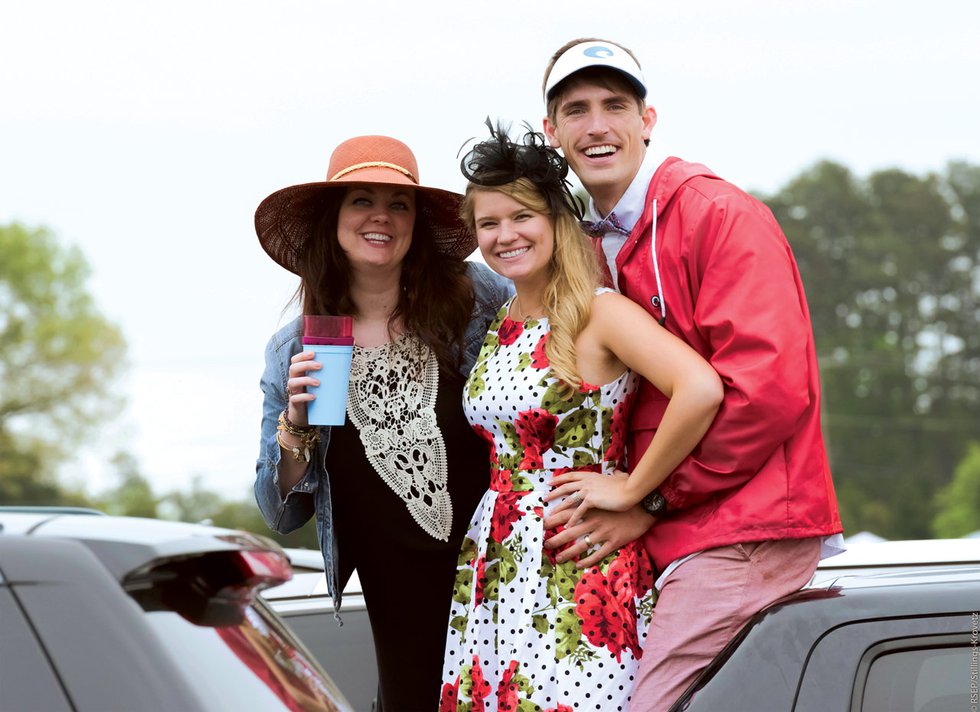Horseback shooting dog trials test a gun dog’s wit and will, but even the most steady to wing and shot can give in to temptation. A bird can be irresistible, after all.







It is midmorning on a chilly April day. The wind is whipping tall golden grass into funnel shapes throughout the rolling fields of Greenfields Farm in Scottsville. I walk my mount towards a group of a dozen or so other riders already gathered near an ATV loaded with steel crates packed with English pointers and setters. Some of the dogs press their noses against the mesh, wiggling eagerly, while others sit calmly as if to say, “Don’t worry, I’ve got this.”
We are waiting for the start of the Amateur Derby stake in the Esmont-Greenfields Virginia Classics—a horseback shooting dog trial. Despite the chill, the group seems in good spirits as Greenfields owner and avid shooting dog trialer John Milton guides his horse through the group greeting all of his guests. I am thankful for the breakfast of scrambled eggs, cheese grits and bacon served earlier in the farm’s workshed turned clubhouse, an Esmont-Greenfields tradition, I am told by club member Vivian Searcy. The course encircling part of the 750-acre farm is between six and seven miles long, she explains, and we will be out for a few hours at least.
My borrowed chestnut saddlebred is practically dancing he is so ready to go—other horses snort puffs of steam into the air or stomp their feet as the competitors and the gallery of more than a dozen riders gathered to watch today’s stakes exchange some good-natured banter. It’s a tightknit group.

Bonifide Bocephus, owned by Darrell Miller of Center Cross, and Stargell’s Money Penny, owned by Kirk Regensburg of Mechanicsville, will run the winding course together as brace mates in the first stake in an intricate race to sniff out and point at liberated quail released by the bird planter before it begins. (To keep the birds from flying away, the bird planter holds them firmly in a gloved hand and, using a twirling motion similar to the wrist rotation that cowboys use to spin a lasso, “dizzies” the quail, disorienting them until they are flushed.)
Penny, a smallish, mostly white, female English pointer (referred to simply as a pointer in the U.S.) and Bo, an orange, white and ticked male English setter, both two years old, are practically pulling out of their collars, noses twitching in the air, ready to run. Their respective owners work to attach orange tracking collars around their necks in case one of them gets lost in the excitement. The dogs are lined up next to each other, and a timer is set for 30 minutes. Miller lets Bo know with a few soft words that he is close by on horseback. In just a few moments judges Steve Mills—who has come from Mayodan, North Carolina—and Julie Richards of Charlottesville give the signal to start, and both dogs leap forward into a dead run like race horses released from the starting gate. In seconds they are white streaks across a rolling field weaving in and out of scruff in a high speed minuet, going wide and then crossing paths, tails sticking straight up and cracking, the sport’s term for the frantic waving motion.
“The people that come to these trials love their animals, and we enjoy sharing the sport with each other.”
As we ride over meadows, through brush and woods, the dogs traverse the course in wide sweeps with Miller and Regensburg yipping and whistling to keep them in check. Each owner has a different language of sounds to communicate with his dog—think cowboys herding cattle in old-time westerns. The judges watch for the dogs to find some quail and freeze at point. Part of the magic that happens between a dog and its handler is understanding “dog-to-human” communication, says Tommy Stargell of Scottsville, Penny’s breeder, “You must be able to read your dog.”
About 15 minutes into the brace, Penny finds her first quail and freezes into a perfect point. Her compact body looks sturdy with feet planted evenly under her shoulders and hips leaning ever so slightly forward. Her tail is antenna-like. Her square-ish head features a white face flanked by liver colored ears with a brownish nose leading the way. She is confident, regal.
“Penny came out of the box holding her head up,” says Regensburg, later. “She was the runt of the litter, but she picked us. She followed my wife around as we looked at the other pups to the point where we just had to bring her home. But she has always had this attitude of ‘I’m it! I am the thing!’” Penny definitely has panache.
Regensburg dismounts and hands the reins to a member of the gallery, then he walks in front of Penny and begins to shuffle his feet—he must prove that there are quail in the spot for Penny to win points with the judges. This moment is critical because the dog must stand absolutely still until commanded otherwise as the quail are flushed and a pistol loaded with blanks is fired. No quail are harmed during the event—with the exception of being made dizzy.
Penny does splendidly, and she is released to look for more quail. The gallery walks and trots behind the judges as both dogs continue their search crossing ice-cold streams and bounding up a short hill or two. The musty smell of damp horses and red mud is cleared by brisk gusts, and I am grateful to be wearing a down jacket and gloves. The wind makes it more difficult for the dogs to detect quail scent, and though Bo runs beautifully, birds elude him—he will head home ribbonless.
“The people that come to these trials love their animals, and we enjoy sharing the sport with each other,” says Milton. “We ride horses, and we all love horses, but the competition is about the dogs. What draws us to keep doing it is the hope that maybe this time when we turn him loose the dog will do a good job.”
A nail-biter happens in a stake later in the day when handler Frank Henderson of Calico Kennels in Jetersville misreads his five-year-old black and white male pointer, Calico’s Cowboy Casanova, in the first few minutes of the 60-minute stake. At three minutes in, the dog points at an area where birds have already been flushed. Though there is probable cause to doubt the validity of the point, Henderson decides that the dog knows best and proceeds to shuffle through the area in an attempt to flush any remaining birds. When no birds are found the dog is marked with an “unproductive find.” Two “unproductives” in a stake disqualify a dog. Luckily, Cas earns eight clean finds (incidents where he points to live birds) in the remainder of the stake without another unproductive, later earning him a win and a ribbon.
The unpredictability of the sport is part of its appeal. “It’s not what he did yesterday. It’s not what he did 12 minutes ago,” Stargell explains about dogs. “It’s what he’s gonna do that particular day, and even the best one will make a liar out of you.”
Sometimes, says Milton, even very well trained dogs get so excited by the presence of the quail that they forget to stand still and run at the birds. “Just because a dog is broke doesn’t necessarily mean it will stand when the quail are flushed,” he says. “We have a saying around here when that happens. There goes my dog. There go the birds, and there goes my hundred dollars” (for the entry fee).

After a break for lunch, the Amateur Puppy Stakes begin. Three pointers, two setters and one German shorthaired pointer compete in this, the greenest group of trialers. It’s a big day for the club because Stargell’s 8-year-old grandson, Mason Holland, is making his handler debut with Holland’s Cadence, the female German shorthaired pointer he shares with his 7-year-old brother, Andrew.
Mason looks small in his big bowl-like riding helmet, perched atop a black and white pinto pony named Richard. His legs barely reach halfway around Richard’s middle, but he obviously knows what he’s doing. He keeps Richard well under control while he whoops and whistles like a pro to the running Cadence, much to the delight of the gallery. Stargell radiates pride as he follows along with Andrew nestled in front of him on his saddle.
“Little boys are like little dogs, you don’t want to put too much pressure on them,” says Stargell. The puppy stakes is about showing potential rather than expertise. Cadence points, but because this level of contest does not require these 2-year-old novice dogs to be still while the quail are being flushed and the pistol fired, her point break is acceptable.
At the end of the stake as we head across a rolling field toward the house for the awards ceremony, the afternoon sun brightens the newly green grass, and the large white farmhouse gleams in the near distance with postcard perfection. We are all tired and conversation dwindles, but the horses—and riders for that matter—perk up in anticipation of food and rest. The dogs have already been returned to their crates and driven back to their owners’ combination horse trailer/RVs for kibble and perhaps a treat.
Pulled pork barbecue, fresh rolls, coleslaw and baked beans are served in the clubhouse. Mason Holland waits with great anticipation to learn if Cadence places in the puppy event while Andrew suffers through a few bites of coleslaw to earn a brownie for dessert.
I ask Mason what he likes most about field trialing. He pauses, and then looks up at Stargell beaming, “Getting to spend time with my Grandpa.” That, and perhaps the fourth place ribbon he takes home.
This article originally appeared in our October 2017 issue. Click here for more information on the Esmont-Greenfields Field Trial Club and its efforts to invest in the future of the sport.








